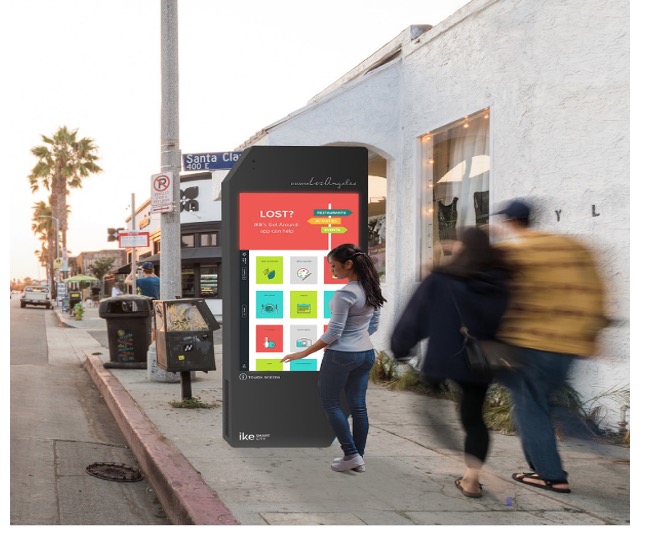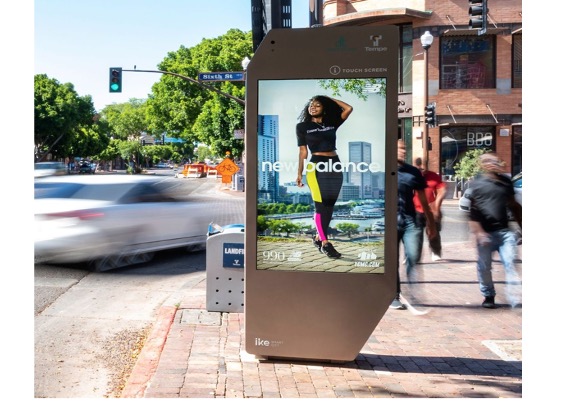CommentsLA TRANSPO - To those of us who followed the recent adoption of the new City street furniture program “STAP” (Street and Transit Amenity Program), the emergence of yet another advertising program “IKE” (Interactive Kiosk Experience) comes as no surprise.
We view IKE as a calculated politically tainted effort to take over yet more of our precious shared public right-of-way with commercial advertising structures.
The IKE Program, poised to come before the LA City Council very shortly (as early as this week or next), seeks to place between 300 - 500 bulky 8-foot tall digital ad kiosks on Los Angeles’ sidewalks under the guise of providing tourists with needed information. When tourists or locals are not using the kiosks, they will be used to broadcast advertising messages to generate funds for the City and the LA Tourism and Convention Board. That Board is the agency that hatched this plan back in 2015 but that could not implement it (despite a Letter of Intent signed with the selected vendor IKE Smart Cities, LLC in 2017) until the City adopted a new LA Municipal Code (LAMC) that allows for new ad structures in the public right-of-way in addition to those that have been permitted exclusively for transit shelters.
Whether being used interactively or for streaming advertisements, the IKE structures will be invading our privacy by capturing the geolocation data of all who use them or pass in their vicinity!
(But) why would Mayor Garcetti, soon to leave office, and other City electeds be so dedicated to promoting a program that appears to conflict with the City’s General Plan, its Mobility Element, area Specific Plans, undermine the 2002 Sign Ordinance, and introduce new driver distractions all while occupying the very precious shared public open space that we enjoy on our City streets? Could the lure of a share of advertising dollars/revenue answer this question? Are we adding more and more ad structures on our sidewalks to satisfy promises the Mayor made to the Olympics or other upcoming event sponsors? Why have those behind IKE purposely avoided any public engagement, communication with Neighborhood Councils and affected communities to seek feedback on the proposed program? And, what’s the hurry to expedite IKE without an RFP (request for proposal) process?
IKE is moving forward under the radar toward Council approval amidst a clear effort to avoid public engagement. There has been NO notice, NO outreach, NO transparency, and NO opportunity for meaningful public input. While Neighborhood Councils are charged with advising the City under the City Charter, they cannot provide that advice if the City has left them completely out of the process.
The IKE Program has been developed, supported, and is being fast-tracked by the the Mayor’s Office, tourism interests and Council leadership. Important documents that were originally posted to the City’s Council File system are no longer available for public viewing; instead when one attempts to see the planned distribution of IKE structures among council district areas, or to view staff reports or the specific streets targeted for shelters, one is presented with the following message:
Access to cityclerk.lacity.org was denied
You don't have authorization to view this page.
Fortunately, most of those files including detailed maps were saved by concerned citizens when first posted and can now be viewed on the Scenic Los Angeles website.
IKE consists of a 12-year long-term contract with two 5-year extensions possible. Yet, the City has not issued an RFP seeking bids from qualified vendors for the program who might provide the City with the best available technology. The Tourism and Convention Board began working with IKE Smart Cities, LLC (a sister to Orange Barrel Media, an Ohio company) back in 2016 to implement a pilot program. Despite the fact that a case has not been made to justify a sole source procurement process, no RFP was issued following completion of the pilot program. Instead, in its efforts to expedite review and approval of IKE with its pre-selected vendor, the City is proposing a “piggyback” contract – relying upon the City of Houston’s RFP for their IKE program in lieu of doing an RFP for LA’s program.
Yes, Virginia, this smacks of yet another back-room deal at a time when City Hall and its electeds can ill afford compromising whatever remains of City Hall credibility.

The Texas IKE program with 125 kiosks is a much smaller program than LA’s proposed program that plans a roll out of from 300-500 ad kiosks. Houston is a very different environment and their needs and local resources are likewise very different. If IKE moves forward in some form, LA’s media companies deserve a fair opportunity to compete for the business. And, communities should have an opportunity to have input into the RFP’s design. It is not enough for the Tourism and Convention Board to have consulted with their partners in tourism and hospitality in 2016; these proposed structures will have a direct impact on the City’s aesthetics, on our daily experience as we traverse our streets and may replace other sidewalk uses (trees, restaurant dining...), etc. They will commercialize a shared public asset at a time when we are regularly faced with unwanted commercial messages as we wait in lines, pump gas, view email and phone messages.
It is important to note that these structures, like the STAP structures, will capture information about those who use them and who pass them by – this without any permission to do so. This invasion of our privacy as we traverse our neighborhood and City streets is a violation of our Constitutional rights.
The IKE Program’s advancement via high level closed-door dealings has raised RED FLAGS even for the City Attorney, who issued an unprecedented public Report, sent last week to the City Council (Council File #22-1154). The City Attorney detailed the seven steps that must be taken before determining whether the IKE contract can be entered into. They include a CEQA environmental analysis, determination whether the “piggyback” contract approach conforms with LAMC; preparation of a proposed contract; City department contract approval; Board of Public Works approval; CAO report with Program evaluation and financial analysis; City Council approval.
It is important that the public voice is heard:
SUBMIT A WRITTEN COMMENT TO THE COUNCIL FILE. Please consider voicing your opposition in a post to the Council File and copy your LA City Councilmember. You can submit your comment directly to Council File # 22-1154 using this link.
Include all of your reasons for opposition and ask the Council to adopt Councilmember Bonin’s Minority Report presented to the Council’s Committee on Trade, Travel and Tourism. Urge them to engage in a full and transparent outreach and public review process.
CALL YOUR COUNCILMEMBER: Tell your Councilmember to OPPOSE the IKE Program, and to send it back for financial and environmental analysis, and a competitive bidding process with public input.
SPREAD THE WORD! Help put a stop to IKE and protect our visual landscape. Share this message with your neighborhood listservs, NextDoor community, and others who can help us flood our City officials’ mailboxes with the message that IKE is not good for Los Angeles.
(Barbara Broide is President of the Westwood South of Santa Monica Blvd. Homeowners Association. She is also a Board Members of the Coalition for a Scenic Los Angeles.)
